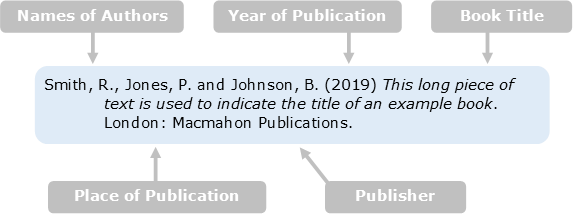What are the many types of academic reference?

This is the first of three chapters about References and Reference Lists. To complete this reader, read each chapter carefully and then unlock and complete our materials to check your understanding.
– Introduce the structure of this short course on references
– Discuss what references are and how and when to use them
– Explore the concept of reference styles and source types and how they affect reference formatting and elements
Before you begin reading...
-
video and audio texts
-
knowledge checks and quizzes
-
skills practices, tasks and assignments
Chapter 1
Anyone that’s ever had to write an academic essay or create an academic presentation will know that it’s important to include citations, references and a references list in that assignment to guarantee correct academic conduct. However, because there are so many referencing styles in use, and because how citations and references are formed can be fairly rule-dependent, many students often struggle with accuracy when referencing – which could leave them open to accusations of plagiarism and more general academic misconduct.
To help students in this area, we’ve created many short readers on referencing such as this reader about references and reference lists. In Chapter 1, we explore the basics of a reference, introducing some key variation based on the referencing style and source type being used. Following this, Chapter 2 provides comprehensive instructions for how to accurately write references, with Chapter 3 focusing more specifically on the creation, ordering and layout of academic reference lists. If you’re ready to study, continue reading…

What is a reference?
If you completed our short reader on citation types, you should already know that any time a writer wishes to include facts, examples, evidence, ideas, opinions or claims from another author and source, that writer should create an in-text citation in their work that tells the reader where that information came from. However, because citations are intended to be brief, they do not contain all of the source details that are necessary for other researchers to successfully locate that source.
Correspondingly, end-text references are longer pieces of text that are placed at the end of an assignment within a reference list. Such references are used to inform the reader of the sources that were cited in that assignment or published work, providing source details such as the authors’ names, the year of publication, the title of the book or journal article and the name of the publisher:

Are referencing styles important?
The above example reference has been created using a particular style of referencing known as the Harvard Style. Students must understand that when building references there are many different styles that might be required depending on the university, the major and the tutor. As the following examples show, the same reference example written in Chicago or MLA styles looks quite different:


Because of the clear differences in formatting, layout and ordering, it’s very important that students understand which referencing style they are required to use before writing their reference list. Furthermore, and as the next section better explains, knowing which source type needs referencing is also the key to accuracy.
What are the 10 most common source types?
When creating references, it’s very important that students first determine the source types they’re using for their research. Whether you’re referencing a chapter in a book, a journal article or a webpage, how the reference is ordered and which reference elements are required will all depend on these types. To assist students in recognising reference-formatting for ten common source types, we’ve provided example references for you below:
1. Books in Print
Smith, R., Jones, P., Lee, Z. and Johnson, B. (2019) This long piece of text is used to indicate the title of an imaginary example book. London: Macmahon Publications.
2. Books with Contributing Authors
James, K. (2016) ‘Insert Chapter Title’, in Smith, R. (ed.) This long piece of text is used to indicate the title of an imaginary example book. London: Macmahon Publications, pp. 66-74.
3. Conference Proceedings
Smith, R. (ed.) (2016) This long piece of text is used to indicate the title of an imaginary conference proceeding. SOAS, London, 16 July. London: Macmahon Publications.
4. Diagrams in Books
Smith, R., Jones, P., Lee, Z. and Johnson, B. (2019) This long piece of text is used to indicate the title of an imaginary example book. London: Macmahon Publications, p.66, diagram.
5. Digital Photographs
Jones, P. (1999) The title of the photograph. Available at: https://photographs.com/the-title-of-the-photograph/ (Downloaded: 01 November 2019).
6. e-Journal Articles
Atkinson, P. (2000) ‘The title of the article’, The Title of the Journal, 16(3), pp. 33-45. Available at: https://journals.edu.uk (Accessed: 01 November 2019).
7. Newspaper Articles in Print
Lee, Z. (2001) ‘The title of the article’, The Name of the Newspaper, 11 June, pp. 04-05.
8. Social Networking Sites
Johnson, B. and Blair, T. (2001) Title of the webpage, [Name of the Social Networking Site] 30 March. Available at: https://socialnetworking.com/johnson-and-blair/ (Accessed: 01 July 2019).
9. Theses in Print
Blair, T. (2003) The title of the published PhD thesis. PhD thesis. University of London.
10. Web Pages
Jones, P. (2015) The title of the webpage. Available at: https://onlinewebpages.edu.uk (Accessed: 13 August 2018).
Having now explored the basic concepts of end-text references, students may next wish to complete our Chapter 1 activities and continue studying with Chapter 2.
Please note: there are many different possible referencing styles such as APA or Chicago. All examples demonstrated in this chapter are of the Harvard Style of referencing as in Cite Them Right.
To reference this reader:
Academic Marker (2022) References and Reference Lists. Available at: https://academicmarker.com/academic-guidance/referencing/referencing-features/references-and-reference-lists/ (Accessed: Date Month Year).
Downloadables
Once you’ve completed all three chapters in this short reader about References and Reference Lists, you might then wish to download our Chapter Worksheets to check your progress or print for your students. These professional PDF worksheets can be easily accessed for only a few Academic Marks.
Chapter 1 explores the topic: What are the many types of academic reference? Our Chapter 1 Worksheet (containing guidance, activities and answer keys) can be accessed here at the click of a button.
Chapter 2 explores the topic: How can I write accurate references in English? Our Chapter 2 Worksheet (containing guidance, activities and answer keys) can be accessed here at the click of a button.
Chapter 3 explores the topic: How can I create, lay out and order reference lists? Our Chapter 3 Worksheet (containing guidance, activities and answer keys) can be accessed here at the click of a button.
To save yourself 2 Marks, click on the button below to gain unlimited access to all of our References and Reference Lists Chapter Worksheets. This All-in-1 Pack includes every chapter, activity and answer key related to this topic in one handy and professional PDF.
Collect Academic Marks
-
100 Marks for joining
-
25 Marks for daily e-learning
-
100-200 for feedback/testimonials
-
100-500 for referring your colleages/friends